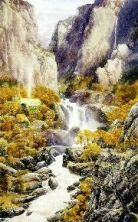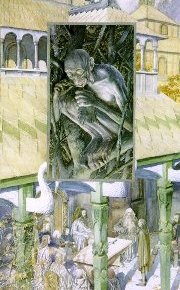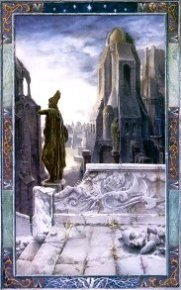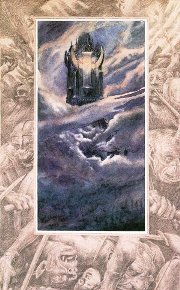Tolkien Calendar: The Great Years
Tolkien Calendar: The Great Years
October 24, TA 3018
24 October 2005 14:25:34Categories: Tolkien Calendar
Frodo recovers and wakes. Boromir arrives in Rivendell at night.

Ah, Rivendell! Who among us wouldn't endure the terror of the Black Riders to find ourselves waking up in one of Rivendell's many peaceful rooms, with its richly carved beams and patches of sunlight on the walls? Why is it that this place has captured the imaginations of so many artists?
Quote:
Frodo was now safe in the Last Homely House east of the Sea. That house was, as Bilbo had long ago reported, 'a perfect house, whether you like food or sleep or story-telling or singing, or just sitting and thinking best, or a pleasant mixture of them all'. Merely to be there was a cure for weariness, fear, and sadness.
But Imladris is no ordinary country inn. Elrond Half-Elven is Middle-earth's loremaster, and Frodo is in extraordinary need of wisdom. And, 'by chance', as it seems, all those who are needed to tell the full story of the Ring and Middle-earth's peril appear in the same place at the same time. By chance.
Calendar entry by Merry
Artwork: "Rivendell" by Alan Lee
Calendar entry by Merry
Artwork: "Rivendell" by Alan Lee
October 25, TA 3018
25 October 2005 14:26:08Categories: Tolkien Calendar
Council of Elrond.

October 25 is undoubtedly the single most important date in the early annals of the War of the Ring. This is the day that the Free Peoples of Middle-earth make a decision that will shape their future for all time. Differing ideas are debated; sobering accounts of the history of Middle-earth are told; mysteries are unraveled, and both fears and hopes are kindled. The reader is given more insight and history and motive in this one incredible chapter than anywhere else in Tolkien's epic tale.
Needless to say, one short Tolkien Calendar post cannot begin to express the significance of the Council, and so we will talk about it in installments. You will want to check in with the Calendar in the weeks to come and learn about the Council of Elrond from 4 different perspectives.
11-1-05: The Council of Elrond: The Players. Who were the key players in the Council? Why were they key players? What role did they play throughout the Council?
11-8-05: The Council of Elrond: Middle-earth History. What were the historical events that took place in Middle-earth and were discussed at the Council? What key historical events shaped the Council and it's results?
11-15-05: The Council of Elrond: The Decisions and Implications. What did the Council decide to do? What did they consider and throw out and why? What was the significance to the rest of the story.
11-22-05: The Council of Elrond: Tolkien's Literary History. How did Tolkien arrive at his final draft for the Council? What other versions did he consider and disgard and why? What was the literary significance of the final draft?
Join us for these fascinating Calendar posts in November.
Artwork: "The Council of Elrond" by Alan Lee
October 25, TA 3018
25 October 2005 15:26:23Categories: Tolkien Calendar
Key Players at the Council of Elrond

The Council of Elrond is the last meeting of the Free Peoples of Middle Earth in the Third Age. Elrond Halfelven convenes the Council in the fall of 3018 TA at his Rivendell stronghold to decide the fate of the One Ring, which has come into the possession of the Baggins family, hobbits of the Shire. This will be the first time hobbits participate in the councils of the Great Ones, as they call them, and in the affairs of Middle Earth beyond the Shire.
Elrond Halfelven moderates the debates of the Council, and explains the history of the Rings of Power and the fight against Sauron up to the finding of his lost Ring. He is Middle Earth's greatest loremaster, and his word will carry great weight at the Council. He guides it gently toward the only answer that can be made to the question of the Ring--to destroy it in the Fires of Mount Doom. Elrond also has the sad duty to inform the Council that if the One Ring is destroyed, the remaining Three, which have done so much to protect Middle Earth, will likely fail. He knows he is presiding over the Doom of his people, but realizes it is a sacrifice they are willing to make to defeat Sauron.
Legolas, son of Mirkwood's ruler Thranduil, comes to the Council representing Wood Elves. One of his duties includes informing the Council that Gollum, left in the charge of his people, has escaped--an event which will have much bearing on the Ring Quest. Legolas will be one of the Nine Walkers, charged with representing the Elves.
Gloin and his son Gimli come from the Dwarves, who have journeyed to Imladris despite the ages-old emnity between Elves and Dwarves to seek Elrond's counsel about visits they have been receiving from the Nazgul, who are looking for a plain gold ring, in exchange for which they will give rich gifts--"rings as of old." The Dwarves are suspicious, particularly since the demands have become more strident of late, and the Nazgul are threatening punishment if the Dwarves cannot produce the Ring, or at least some knowledge of the thief who stole it, who is believed to be known to them. Elrond realizes that their story lends credence to his belief that Sauron is actively seeking the Ring, and that the Council's time to decide is short.
Indeed the thief is known to the Dwarves, for of course he is Bilbo Baggins, who found the Ring on his journey with them to the Lonely Mountain. He has passed the Ring on to his heir Frodo Baggins. Both hobbits present their stories at the Council, and bravely offer to take the Ring to Mordor. Frodo is the chosen Ringbearer, and around him all decisions taken by the Council revolve. For the first time, hobbits are center-stage in Middle Earth affairs.

Aragorn, Son of Arathorn, who helped Frodo get safely to the Council, now reveals himself as Isildur's Heir, and the rightful King in Exile of Gondor and Arnor. Any question of the Ring concerns him closely, for he cannot come into his own without the defeat of the Dark Lord. He too will be one of the Walkers.
Boromir, son and heir of Denethor, Ruling Steward of Gondor, has come to Elrond for help interpreting a dream he shared with his brother Faramir concerning Isildur's Bane, now revealed to be the Ring. To his surprise and displeasure, he discovers not only Isildur's Bane, but his Heir as well. That Heir intends to come to Minas Tirith and claim his throne. A man seemingly born to rule, Boromir is unsure that Gondor needs a king. Nevertheless, he throws his support behind the decisions of the Council, with one caveat. He is sure the Ring should be used against Sauron. He backs down temporarily in the face of the Council's advice against this, but never really lets go of the idea. Since he will be chosen as one of the Nine Walkers, his belief the Ring should be used will have great bearing on the outcome of the Quest.
The last of key players is the most important. Gandalf the Grey comes to the Council to offer information he has gathered on the Ring and to tell the story of how he tried to protect both it and Frodo from the Enemy. He also informs the Council of the dire perfidy of Saruman, who has cast his lot with the Enemy, while at the same time entertaining designs of his own concerning the Ring. But he is much more than a source of lore. For thousands of years Gandalf has opposed Sauron, and now his hour has come. It is for him to inspire and lead the Free Peoples in their last battle against the Dark Lord, an end for which he has worked tirelessly. The Ring Quest is the last and most important in a long line of perilous undertakings for the Istari in the name of the White.
These representatives on the Council of Elrond hold the future of Middle Earth in their hands--the rest of the story is shaped by their actions and their decisions, right or wrong, good or ill.
Calendar entry by librislove
Artwork: "Rivendell" and "The Council of Elrond" by Alan Lee
October 25, TA 3018
25 October 2005 16:41:31Categories: Tolkien Calendar
The Council of Elrond: Middle-earth History

In the beginning, the earth was begun with a song. Eru sang and the Valar joined in and wove into Eru's main melody harmonies. Melchor, for reasons Tolkien never makes clear, weaves into the song discord as he tries to control it. Eru always turns the discord into beauty but Melchor keeps trying to wrest the song away until he is banished forever. Perhaps it is the interwoven strains of the melody that we see in the events that lead up to the War of the Ring.
The foundations for the War of the Ring were laid in the First Age. To the Elves, this age was known as the Eldar Days. It was in this time that Sauron appeared as a servant of Melchor who came to be called Morgoth. Sauron was of the order of the Maiar and in these days he was still fair to behold and quite charming. The first age ended with the final destruction of Morgoth and his servants in rout. The Second age began as a peaceful age.
Both Men and Elves had fought against Morgoth but it took the intervention of the Valar to bring him down and it caused the lands where the men lived to be flooded. As a reward, the men were given the Island of Numenor for their home. They were allowed to sail anywhere but to the west and the land of the Valar. These men had long been friends of the elves, were long-lived and proud men. They were called the Dun-Edain, Men of the West. The lived in Numenor and, for many long years, were content to sail to Middle Earth exploring the seas lands in that direction. They received many visits from the elves who would visit from the Undying lands and they became jealous of the Elves immortality and restless with the ban on sailing to the West.
In the meantime, some of the Elves, including Celebrimbor and Elrond, had settled Erigion Region, also known as Hollin, of Middle Earth. In about the Year 1200 Sauron appears in Erigion and wins the trust of Celebrimbor. Together they begin to forge the great rings. Together, Celebrimbor and Sauron make the Nine rings for the kings of men and the 7 rings for the dwarf lords. Using the knowledge gained from Sauron Celebrimbor makes the Three, Narya, Nenya and Vilya. Narya is passed to Cirdan who gave it to Gandalf when he arrived in Middle Earth, Nenya was given to Galadriel and Celebrimbor kept Vilya. It took some time to complete the Rings. The three were completed in 1590 and Sauron completed the One Ring in 1600. Of course as soon as he put it on the Elves knew his intent and hid the three.
By 1697, Sauron attacks the Elves, Celebrimbor is killed and Hollin is destroyed. Vilya is passed to Elrond, who takes his place as an Elf Lord and builds Rivendell. For long years the Elves, Elrond, Galadriel, and Thranduil defend their small corners of middle earth from Sauron and the time creeps by.
The Nazgul are first seen in about 2255 of the SA. These are kings of men who were each given one of the Nine. These were not bad men, but because Sauron had a hand in the making of the Nine, the rings worked to corrupt their hearts. Furthermore, it appears that the rings could give immortality to the kings. They did not die, but became as Bilbo later put it "stretched" and thin and they became wraiths neither living nor dead.

The war between Sauron and the Elves wages on. In support of the long friendship between the Men and Elves, the Dun-adain come from Numenor to aid the Elves in the battles. Near the end of the age King Al-Pharazon (who had usurped the crown of Numenor) sails to Middle Earth and captures Sauron. Al-Pharazon returns to Numenor with Sauron who seduces him and convinces the king to sail west to attack the Valar. The Valar destroy Numenor and almost all of the men in it. Only a few of the loyal were spared. These few, including Elendil, Isildur and Anarion, sailed to Middle Earth and settled in what became Gondor. At about the same time, Sauron returns and takes up residence, in secret, in Mordor.
The tempo in the music is quickening now. The end of the Second age is nearing. In the year 3329SA, Sauron attacks Gondor and captures Minas Ithil, "Tower of the Moon" which become Minas Morgol, "Tower of Sorcery". In 3430, the last Alliance of Men and Elves is formed and in 3441, Sauron is defeated in the War of the Last Alliance when Isildur cuts the One Ring from Sauron's hand. The Tower of Barad-Dur is destroyed but Mount Doom survives.
Because Sauron had infused into the One Ring so much of his own power, while the ring endured Sauron endured though he was greatly diminished. Again, the pride of the Men of Numenor show through and Isildur refuses to destroy the Ring so Sauron remains. And the Second age ends.
In the Second year of the third age, Isildur is killed attempting to escape form Orcs and the Ring falls into the Anduin and drops from sight and nearly memory.
In the Year 1000TA, the Istari, the wizards arrive. It appears that the greatest of these is Saruman but it not to him that Cirdan gives his ring. Cirdan gives Narya to Gandalf when he arrives. So, the tune is slow and perhaps quiet for some 2461 years as the Ring lies hidden and as Sauron gathers his strength until at last the Ring is found or allows itself to be found by Gollum. Even so, it stays hidden still for another 500 years when Bilbo finds it and takes it out of its deep caves.
All this time Sauron is not still. He has been slowly growing in strength. He infested the Greenwood for a time and filled it with darkness and evil till it came to be known as the Mirkwood. Eventually the Elves and the Wizards drove him out but the wood was never restored to its former glory. He is driven out of the Mirkwood, but he returns to Mordor and begins to gather his armies. The music quickens.
Bilbo has found the ring and Sauron gathers the Nazgul to him and sent them out to search for it. Gandalf discovers the truth about the Ring and the stage is set for the beginning of the climax that has brought all of these peoples to Rivendell and to the Council of Elrond. The music quickens.
Calendar entry by elizabeth
Artwork: "The Ruins of Osgiliath" and "Red Eye of Sauron Atop Barad-dur" by Alan Lee
October 25, TA 3018
25 October 2005 17:26:28Categories: Tolkien Calendar
The Council of Elrond: Decisions and Implications

Shippey (in the appendix to "The Fellowship of the Ring" movie) compares the Council of Elrond to a badly chaired committee meeting and critics claim that this chapter in LOTR breaks all the rules of good writing, the first of which seems to be "Don't write thirty-two pages of straight dialogue!" But not only are crucial decisions made at the Council of Elrond, but they are made by the only people who could make them, and the implications of these decisions are world-saving.
For I think Elrond and Gandalf knew before the Council that the Ring had to be destroyed in the fires of Mount Orodruin, and they knew that Frodo had to be the Ringbearer. Strictly speaking, being a good portion of what was left of The White Council, Elrond and Gandalf had the authority to issue an order to this effect, and they would probably have been obeyed. But this mission was different: those who pursued it could very well give their lives for it, and that should be done only with full understanding and free will. So the Council had two purposes: education and consensus.
First, everything that was known about the Sauron and the Rings of Power had to be told to all. (elizabeth's admirable Calendar post last week brought us up to speed on that!) Secondly, the options are considered: Hide it. Use it. Throw it in the sea. Send it to Valinor. The members of the Council use all of their wisdom to consider what is to be done. Finally, this wisdom is based on their own understanding of what their purpose and duty are as citizens of Middle-earth in the Third Age. They understand that the Valar view them as children no longer, and so they must deal with the Ring themselves. They know that Sauron is eternally relentless, and so the solution must be permanent, if at all possible. And they know that in a contest of strength, Sauron will win; and so their victory can only come through unexpected ways.
It is a desperate gamble, based on all the wisdom they have, carried out in complete hope for Middle-earth and little hope for themselves. Of the Nine Walkers, probably only Sam, Merry, and Pippin expect to return, because they don't know any better. The implications? The Fellowship makes itself the opposite of Sauron: selfless, powerless, small, reliant on others, and hidden.
It is a desperate gamble and it all comes down to this:
Quote:
'Thus we return once more to the destroying of the Ring,' said Erestor, 'and yet we come no nearer. What strength have we for the finding of the Fire in which it was made? That is the path of despair. Of folly I would say, if the long wisdom of Elrond did not forbid me.'
'Despair, or folly?' said Gandalf. 'It is not despair, for despair is only for those who see the end beyond all doubt. We do not. It is wisdom to recognize necessity, when all other courses have been weighed, though as folly it may appear to those who cling to false hope. Well, let folly be our cloak, a veil before the eyes of the Enemy! For he is very wise, and weighs all things to a nicety in the scales of his malice. But the only measure that he knows is desire, desire for power; and so he judges all hearts. Into his heart thought will not enter that any will refuse it, that having the Ring we may seek to destroy it. If we seek this, we shall put him out of reckoning.'
'At least for a while,' said Elrond. 'The road must be trod, but it will be very hard. And neither strength nor wisdom will carry us far upon it. This quest may be attempted by the weak with as much hope as the strong. Yet such is oft the course of deeds that move the wheels of the world: small hands do them because they must, while the eyes of the great are elsewhere.'
. . .
'I will take the Ring . . . though I do not know the way.'
'Despair, or folly?' said Gandalf. 'It is not despair, for despair is only for those who see the end beyond all doubt. We do not. It is wisdom to recognize necessity, when all other courses have been weighed, though as folly it may appear to those who cling to false hope. Well, let folly be our cloak, a veil before the eyes of the Enemy! For he is very wise, and weighs all things to a nicety in the scales of his malice. But the only measure that he knows is desire, desire for power; and so he judges all hearts. Into his heart thought will not enter that any will refuse it, that having the Ring we may seek to destroy it. If we seek this, we shall put him out of reckoning.'
'At least for a while,' said Elrond. 'The road must be trod, but it will be very hard. And neither strength nor wisdom will carry us far upon it. This quest may be attempted by the weak with as much hope as the strong. Yet such is oft the course of deeds that move the wheels of the world: small hands do them because they must, while the eyes of the great are elsewhere.'
. . .
'I will take the Ring . . . though I do not know the way.'
Calendar entry by Merry
Artwork: "The Councilof Elrond" by Alan Lee
Artwork: "The Councilof Elrond" by Alan Lee
Last edited: 3 July 2022 14:29:05
